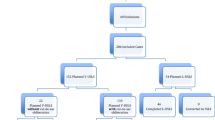Abstract
Introduction and hypothesis
Uterosacral ligament suspension surgery is commonly utilized to correct post-hysterectomy vaginal vault prolapse (VVP). Vaginal intraperitoneal uterosacral vault suspension (IUSVS) is a viable option, but intraperitoneal access can be challenging. An alternative approach is an extraperitoneal uterosacral vault suspension (EUSVS). The aim of our study was to compare surgical outcomes of IUSVS and EUSVS in patients with post-hysterectomy VVP.
Methods
Retrospective cohort study of women who underwent treatment of post-hysterectomy VVP with an IUSVS and EUSVS from May 2016 to January 2019 at our institution. The primary outcome was surgical success that was assessed by a composite outcome for surgical failure, defined as ANY of the following: (1) apical descent > 1/3 of the TVL or anterior or posterior vaginal wall beyond the hymen, (2) retreatment of prolapse, or (3) bothersome vaginal bulge symptoms with a positive response to either of two questions on the PFDI questionnaire. Secondary outcomes included EBL, operative time, duration of hospitalization, and perioperative complications. Two-sample t-tests and chi-square tests were used for the bivariate analysis.
Results
Eighty patients were included (36 IUSVS and 44 EUSVS) with a mean follow-up of 7 months. For our primary outcome, there was no difference in surgical success (IUSVS group 72.22% vs. EUSVS group 81.82%, p = 0.307). Operative time, duration of hospitalization, and EBL were significantly less in the EUSVS group than in the IUSVS group.
Conclusions
EUSVS demonstrated similar short-term success compared to IUSVS for post-hysterectomy VVP, with shorter operative time, EBL, and length of stay.

Similar content being viewed by others
References
Haylen BT, de Ridder D, Freeman RM, Swift SE, Berghmans B, Lee J, et al. An International Urogynecological Association (IUGA)/International Continence Society (ICS) joint report on the terminology for female pelvic floor dysfunction. Int Urogynecol J. 2010;21(1):5–26. https://doi.org/10.1007/s00192-009-0976-9.
Uzoma A, Farag KA. Vaginal vault prolapse. Obstet Gynecol Int. 2009;2009:275621. https://doi.org/10.1155/2009/275621.
Lowenstein L, Gamble T, Sanses TV, van Raalte H, Carberry C, Jakus S, et al. Sexual function is related to body image perception in women with pelvic organ prolapse. J Sex Med. 2009;6(8):2286–91. https://doi.org/10.1111/j.1743-6109.2009.01329.x.
Marchionni M, Bracco GL, Checcucci V, Carabaneanu A, Coccia EM, Mecacci F, et al. True incidence of vaginal vault prolapse. Thirteen years of experience. J Reprod Med. 1999;44(8):679–84.
Aigmueller T, Dungl A, Hinterholzer S, Geiss I, Riss P. An estimation of the frequency of surgery for posthysterectomy vault prolapse. Int Urogynecol J. 2010;21(3):299–302. https://doi.org/10.1007/s00192-009-1033-4.
Montoya TI, Grande KB, Rahn DD. Apical vaginal prolapse surgery: practice patterns and factors guiding route of repair. Female Pelvic Med Reconstr Surg. 2012;18(6):315–20. https://doi.org/10.1097/SPV.0b013e3182713ccc.
Shull BL, Bachofen C, Coates KW, Kuehl TJ. A transvaginal approach to repair of apical and other associated sites of pelvic organ prolapse with uterosacral ligaments. Am J Obstet Gynecol. 2000;183(6):1365–73; discussion 1373-1364. https://doi.org/10.1067/mob.2000.110910.
Jenkins VR 2nd. Uterosacral ligament fixation for vaginal vault suspension in uterine and vaginal vault prolapse. Am J Obstet Gynecol. 1997;177(6):1337–43 discussion 1343-1334.
Karram M, Goldwasser S, Kleeman S, Steele A, Vassallo B, Walsh P. High uterosacral vaginal vault suspension with fascial reconstruction for vaginal repair of enterocele and vaginal vault prolapse. Am J Obstet Gynecol. 2001;185(6):1339–42; discussion 1342-1333. https://doi.org/10.1067/mob.2001.119077.
Jelovsek JE, Barber MD, Brubaker L, Norton P, Gantz M, Richter HE, et al. Effect of uterosacral ligament suspension vs sacrospinous ligament fixation with or without perioperative behavioral therapy for Pelvic organ vaginal prolapse on surgical outcomes and prolapse symptoms at 5 years in the OPTIMAL randomized clinical trial. JAMA. 2018;319(15):1554–65. https://doi.org/10.1001/jama.2018.2827.
Barber MD, Brubaker L, Burgio KL, Richter HE, Nygaard I, Weidner AC, et al. Comparison of 2 transvaginal surgical approaches and perioperative behavioral therapy for apical vaginal prolapse: the OPTIMAL randomized trial. JAMA. 2014;311(10):1023–34. https://doi.org/10.1001/jama.2014.1719.
Barber MD, Visco AG, Weidner AC, Amundsen CL, Bump RC. Bilateral uterosacral ligament vaginal vault suspension with site-specific endopelvic fascia defect repair for treatment of pelvic organ prolapse. Am J Obstet Gynecol. 2000;183(6):1402–10; discussion 1410-1401. https://doi.org/10.1067/mob.2000.111298.
Dwyer PL, Fatton B. Bilateral extraperitoneal uterosacral suspension: a new approach to correct posthysterectomy vaginal vault prolapse. Int Urogynecol J Pelvic Floor Dysfunct. 2008;19(2):283–92. https://doi.org/10.1007/s00192-007-0435-4.
Karmakar D, Dwyer PL, Thomas E, Schierlitz L. Extraperitoneal uterosacral suspension technique for post hysterectomy apical prolapse in 472 women: results from a longitudinal clinical study. BJOG. 2019;126(4):536–42. https://doi.org/10.1111/1471-0528.15560.
Barber MD, Kuchibhatla MN, Pieper CF, Bump RC. Psychometric evaluation of 2 comprehensive condition-specific quality of life instruments for women with pelvic floor disorders. Am J Obstet Gynecol. 2001;185(6):1388–95. https://doi.org/10.1067/mob.2001.118659.
Unger CA, Walters MD, Ridgeway B, Jelovsek JE, Barber MD, Paraiso MF. Incidence of adverse events after uterosacral colpopexy for uterovaginal and posthysterectomy vault prolapse. Am J Obstet Gynecol. 2015;212(5):603 e601–7. https://doi.org/10.1016/j.ajog.2014.11.034.
Author information
Authors and Affiliations
Contributions
D Mounir: Protocol/project development, Data collection/analysis, Manuscript writing/editing.
N Vasquez-Tran: Data collection.
FM Lindo: Protocol/project development, Manuscript editing.
DD Antosh: Protocol/project development, Data analysis, Manuscript editing.
TW Muir: Protocol/project development, Manuscript writing/editing.
Corresponding author
Ethics declarations
Conflict of interest
None.
Additional information
Publisher’s note
Springer Nature remains neutral with regard to jurisdictional claims in published maps and institutional affiliations.
An abstract of this study was presented as a non-oral poster at the Society of Gynecologic Surgeons 46th Annual Scientific Meeting, a virtual event, held July 9–12, 2020.
Rights and permissions
About this article
Cite this article
Mounir, D., Vasquez-Tran, N.O., Lindo, F.M. et al. Vaginal intraperitoneal versus extraperitoneal uterosacral ligament vault suspensions: a comparison of a standard and novel approach. Int Urogynecol J 32, 913–918 (2021). https://doi.org/10.1007/s00192-020-04462-7
Received:
Accepted:
Published:
Issue Date:
DOI: https://doi.org/10.1007/s00192-020-04462-7



